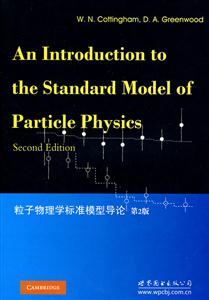扫一扫
关注中图网
官方微博
本类五星书更多>
-
>
宇宙、量子和人类心灵
-
>
考研数学专题练1200题
-
>
希格斯:“上帝粒子”的发明与发现
-
>
神农架叠层石:10多亿年前远古海洋微生物建造的大堡礁
-
>
二十四史天文志校注(上中下)
-
>
声音简史
-
>
浪漫地理学:追寻崇高景观
买过本商品的人还买了
霍金的宇宙-现代物理和天文学的故事
¥24.9¥49.8散度.旋度.梯度释义-(图解版)
¥19.4¥29.0弦理论
¥16.8¥29.0目睹创世:欧洲核子研究中心及大型强子对撞机史话
¥27.3¥42.0纪念核物理学家 王淦昌文集
¥36.3¥98.0
粒子物理学标准模型导论-第2版 版权信息
- ISBN:9787510005541
- 条形码:9787510005541 ; 978-7-5100-0554-1
- 装帧:一般胶版纸
- 册数:暂无
- 重量:暂无
- 所属分类:>>
粒子物理学标准模型导论-第2版 本书特色
《粒子物理学标准模型导论(第2版)》由世界图书出版公司出版。
粒子物理学标准模型导论-第2版 内容简介
本书从介子和夸克的电磁作用和弱相互作用开始,讲到了夸克的强相互作用,内容层层深入。介绍标准模型的同时,作者非常注重选材的可进阶性,方便读者更深入的研读。
粒子物理学标准模型导论-第2版 目录
preface to the second edition
preface to the first edition
notation
1 the particle physicist's view of nature
1.1 introduction
1.2 the construction of the standard model
1.3 leptons
1.4 quarks and systems of quarks
1.5 spectroscopy of systems of light quarks
1.6 more quarks
1.7 quark colour
1.8 electron scattering from nucleons
1.9 particle accelerators
1.10 units
2 lorentz transformations
2.1 rotations, boosts and proper lorentz transformations
2.2 scalars, contravariant and covariant four-vectors
2.3 fields
2.4 the levi-civita tensor
2.5 time reversal and space inversion
3 the lagrangian formulation of mechanics
3.1 hamilton's principle
3.2 conservation of energy
3.3 continuous systems
3.4 a lorentz covariant field theory
3.5 the klein-gordon equation
3.6 the energy-momentum tensor
3.7 complex scalar fields
4 classical electromagnetism
4.1 maxwell's equations
4.2 a lagrangian density for electromagnetism
4.3 gauge transformations
4.4 solutions of maxwell's equations
4.5 space inversion
4.6 charge conjugation
4.7 intrinsic angular momentum of the photon
4.8 the energy density of the electromagnetic field
4.9 massive vector fields
5 the dirac equation and the dirac field
5.1 the dirac equation
5.2 lorentz transformations and lorentz invariance
5.3 the parity transformation
5.4 spinors
5.5 the matrices
5.6 making the lagrangian density real
6 free space solutions of the dirac equation
6.1 a dirac particle at rest
6.2 the intrinsic spin of a dirac particle
6.3 plane waves and helicity
6.4 negative energy solutions
6.5 the energy and momentum of the dirac field
6.6 dirac and majorana fields
6.7 the e ] ] m limit, neutrinos
7 electrodynamics
7.1 probability density and probability current
7.2 the dirac equation with an electromagnetic field
7.3 gauge transformations and symmetry
7.4 charge conjugation
7.5 the electrodynamics of a charged scalar field
7.6 particles at low energies and the dirac magnetic moment
8 quantising fields: qed
8.1 boson and fermion field quantisation
8.2 time dependence
8.3 perturbation theory
8.4 renornmalisation and renormalisable field theories
8.5 the magnetic moment of the electron
8.6 quantisation in the standard model
9 the weak interaction: !ow energy phenomenology
9.1 nuclear beta decay
9.2 pion decay
9.3 conservation of lepton number
9.4 muon decay
9.5 the interactions of muon neutrinos with electrons
10 symmetry breaking in model theories
10.1 global symmetry breaking and goldstone bosons
10.2 local symmetry breaking and the higgs boson
11 massive gauge fields
11.1 su(2) symmetry
11.2 the gauge fields
11.3 breaking the su(2) symmetry
11.4 identification of the fields
12 the weinberg——salam electroweak theory for leptons
12.1 lepton doublets and the weinberg-salam theory
12.2 lepton coupling to the w
12.3 lepton coupling to the z
12.4 conservation of lepton number and conservation of charge
12.5 cp symmetry
12.6 mass terms in : an attempted generalisation
13 experimental tests of the weinberg——salam theory
13.1 the search for the gauge bosons
13.2 the w bosons
13.3 the z boson
13.4 the number of lepton families
13.5 the measurement of partial widths
13.6 left-right production cross-section asymmetry and lepton decay symmetry of the z boson
14 the electromagnetic and weak interactions of quarks
14.1 construction of the lagrangian density
14.2 quark masses and the kobayashi-maskawa mixing matrix
14.3 the parameterisation of the km matrix
14.4 cp symmetry and the km matrix
14.5 the weak interaction in the low energy limit
15 the hadronic decays of the z and w bosons
15.1 hadronic decays of the z
15.2 asymmetry in quark production
15.3 hadronic decays of the w
16 the theory of strong interactions: quantum chromodynamics
16.1 a local su(3) gauge theory
16.2 colour gauge transformations on baryons and mesons
16.3 lattice qcd and asymptotic freedom
16.4 the quark-antiquark interaction at short distances
16.5 the conservation of quarks
16.6 isospin symmetry
16.7 chiral symmetry
17 quantum chromodynamics: calculations
17.1 lattice qcd and confinement
17.2 lattice qcd and hadrons
17.3 perturbative qcd and deep inelastic scattering
17.4 perturbative qcd and e+e- collider physics
18 the kobayashi-maskawa matrix
18.1 leptonic weak decays of hadrons
18.2 |vud| and nuclear decay
18.3 more leptonic decays
18.4 cp symmetry violation in neutral kaon decays
18.5 b meson decays and b,b mixing
18.6 the cpttheorem
preface to the first edition
notation
1 the particle physicist's view of nature
1.1 introduction
1.2 the construction of the standard model
1.3 leptons
1.4 quarks and systems of quarks
1.5 spectroscopy of systems of light quarks
1.6 more quarks
1.7 quark colour
1.8 electron scattering from nucleons
1.9 particle accelerators
1.10 units
2 lorentz transformations
2.1 rotations, boosts and proper lorentz transformations
2.2 scalars, contravariant and covariant four-vectors
2.3 fields
2.4 the levi-civita tensor
2.5 time reversal and space inversion
3 the lagrangian formulation of mechanics
3.1 hamilton's principle
3.2 conservation of energy
3.3 continuous systems
3.4 a lorentz covariant field theory
3.5 the klein-gordon equation
3.6 the energy-momentum tensor
3.7 complex scalar fields
4 classical electromagnetism
4.1 maxwell's equations
4.2 a lagrangian density for electromagnetism
4.3 gauge transformations
4.4 solutions of maxwell's equations
4.5 space inversion
4.6 charge conjugation
4.7 intrinsic angular momentum of the photon
4.8 the energy density of the electromagnetic field
4.9 massive vector fields
5 the dirac equation and the dirac field
5.1 the dirac equation
5.2 lorentz transformations and lorentz invariance
5.3 the parity transformation
5.4 spinors
5.5 the matrices
5.6 making the lagrangian density real
6 free space solutions of the dirac equation
6.1 a dirac particle at rest
6.2 the intrinsic spin of a dirac particle
6.3 plane waves and helicity
6.4 negative energy solutions
6.5 the energy and momentum of the dirac field
6.6 dirac and majorana fields
6.7 the e ] ] m limit, neutrinos
7 electrodynamics
7.1 probability density and probability current
7.2 the dirac equation with an electromagnetic field
7.3 gauge transformations and symmetry
7.4 charge conjugation
7.5 the electrodynamics of a charged scalar field
7.6 particles at low energies and the dirac magnetic moment
8 quantising fields: qed
8.1 boson and fermion field quantisation
8.2 time dependence
8.3 perturbation theory
8.4 renornmalisation and renormalisable field theories
8.5 the magnetic moment of the electron
8.6 quantisation in the standard model
9 the weak interaction: !ow energy phenomenology
9.1 nuclear beta decay
9.2 pion decay
9.3 conservation of lepton number
9.4 muon decay
9.5 the interactions of muon neutrinos with electrons
10 symmetry breaking in model theories
10.1 global symmetry breaking and goldstone bosons
10.2 local symmetry breaking and the higgs boson
11 massive gauge fields
11.1 su(2) symmetry
11.2 the gauge fields
11.3 breaking the su(2) symmetry
11.4 identification of the fields
12 the weinberg——salam electroweak theory for leptons
12.1 lepton doublets and the weinberg-salam theory
12.2 lepton coupling to the w
12.3 lepton coupling to the z
12.4 conservation of lepton number and conservation of charge
12.5 cp symmetry
12.6 mass terms in : an attempted generalisation
13 experimental tests of the weinberg——salam theory
13.1 the search for the gauge bosons
13.2 the w bosons
13.3 the z boson
13.4 the number of lepton families
13.5 the measurement of partial widths
13.6 left-right production cross-section asymmetry and lepton decay symmetry of the z boson
14 the electromagnetic and weak interactions of quarks
14.1 construction of the lagrangian density
14.2 quark masses and the kobayashi-maskawa mixing matrix
14.3 the parameterisation of the km matrix
14.4 cp symmetry and the km matrix
14.5 the weak interaction in the low energy limit
15 the hadronic decays of the z and w bosons
15.1 hadronic decays of the z
15.2 asymmetry in quark production
15.3 hadronic decays of the w
16 the theory of strong interactions: quantum chromodynamics
16.1 a local su(3) gauge theory
16.2 colour gauge transformations on baryons and mesons
16.3 lattice qcd and asymptotic freedom
16.4 the quark-antiquark interaction at short distances
16.5 the conservation of quarks
16.6 isospin symmetry
16.7 chiral symmetry
17 quantum chromodynamics: calculations
17.1 lattice qcd and confinement
17.2 lattice qcd and hadrons
17.3 perturbative qcd and deep inelastic scattering
17.4 perturbative qcd and e+e- collider physics
18 the kobayashi-maskawa matrix
18.1 leptonic weak decays of hadrons
18.2 |vud| and nuclear decay
18.3 more leptonic decays
18.4 cp symmetry violation in neutral kaon decays
18.5 b meson decays and b,b mixing
18.6 the cpttheorem
展开全部
粒子物理学标准模型导论-第2版 节选
《粒子物理学标准模型导论(第2版)》从介子和夸克的电磁作用和弱相互作用开始,讲到了夸克的强相互作用,内容层层深入。介绍标准模型的同时,作者非常注重选材的可进阶性,方便读者更深入的研读。
书友推荐
- >
名家带你读鲁迅:故事新编
名家带你读鲁迅:故事新编
¥13.0¥26.0 - >
伯纳黛特,你要去哪(2021新版)
伯纳黛特,你要去哪(2021新版)
¥15.9¥49.8 - >
新文学天穹两巨星--鲁迅与胡适/红烛学术丛书(红烛学术丛书)
新文学天穹两巨星--鲁迅与胡适/红烛学术丛书(红烛学术丛书)
¥9.9¥23.0 - >
罗曼·罗兰读书随笔-精装
罗曼·罗兰读书随笔-精装
¥20.3¥58.0 - >
李白与唐代文化
李白与唐代文化
¥8.9¥29.8 - >
巴金-再思录
巴金-再思录
¥14.7¥46.0 - >
烟与镜
烟与镜
¥24.0¥48.0 - >
我从未如此眷恋人间
我从未如此眷恋人间
¥24.4¥49.8
本类畅销
-
4.23文创礼盒A款--“作家言我精神状态”
¥42.3¥206 -
4.23文创礼盒B款--“作家言我精神状态”
¥42.3¥206 -
一句顶一万句 (印签版)
¥40.4¥68 -
百年书评史散论
¥14.9¥38 -
1980年代:小说六记
¥52.8¥69 -
中图网经典初版本封面-“老人与海”冰箱贴
¥20¥40






















